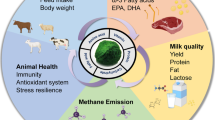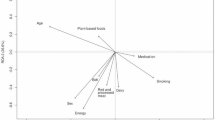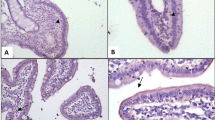Abstract
Understanding the developmental period or the patterns of gut microbiota is important for nutritionists when designing a feed formula or adjusting a feeding strategy. The effects of growth stage or rearing pattern on pig gut microbiota have not been fully investigated. Herein, 39 fecal samples from pigs aged 3–9 months under two rearing patterns were collected to analyze the gut microbiome. Samples were clustered into three distinct groups, namely, early (3 months), middle (5 months), and late (7 and 9 months) stages, using principal coordinate analysis and analysis of similarities test. The rearing-pattern effects were very minimal, and no differences were observed in the alpha diversity [observed operational taxonomic units (OTUs) and Shannon index] of gut microbiota. From early and middle to late stage, Shannon index gradually decreased and OTUs gradually increased. Pigs at early stage were enriched with bacteria from family Prevotellaceae, including the genera Prevotella_9 and Prevotellaceae_NK3B31, whereas pigs at late stage were enriched with family Ruminococcaceae, including genera Ruminococcaceae_UCG-005 and Oscillospira. Pigs in the semi-free-grazing farm group were significantly enriched with bacteria from order Clostridiales. Growth stage better explained the changes in porcine gut microbiota than rearing patterns.





Similar content being viewed by others
Data Availability
The datasets used during the current study are available from the corresponding author on reasonable request. All data in this study are included in this manuscript and its supplementary information files.
Code Availability
All software in this study are accessed via a formal application process.
References
Peled S, Livney YD (2021) The role of dietary proteins and carbohydrates in gut microbiome composition and activity: a review. Food Hydrocolloid 120:106911. https://doi.org/10.1016/j.foodhyd.2021.106911
Verschuren LMG, Calus MPL, Jansman AJM, Bergsma R, Knol EF, Gilbert H et al (2018) Fecal microbial composition associated with variation in feed efficiency in pigs depends on diet and sex. J Anim Sci 96:1405–1418. https://doi.org/10.1093/jas/sky060
Seidel J, Valenzano DR (2018) The role of the gut microbiome during host ageing. F1000research 7:1086
Frese SA, Parker K, Calvert CC, Mills DA (2015) Diet shapes the gut microbiome of pigs during nursing and weaning. Microbiome 3:28. https://doi.org/10.1186/s40168-015-0091-8
Guevarra RB, Hyun HS, Ho CJ, Bo-Ra K, Jiwon S, Hyung LJ et al (2018) The dynamics of the piglet gut microbiome during the weaning transition in association with health and nutrition. J Anim Sci Biotechno 9:54. https://doi.org/10.1186/s40104-018-0269-6
Song M, Zhang F, Chen L, Yang Q, Su H, Yang X et al (2021) Dietary chenodeoxycholic acid improves growth performance and intestinal health by altering serum metabolic profiles and gut bacteria in weaned piglets. Anim Nutr 19:2405–6545. https://doi.org/10.1016/j.aninu.2020.07.011
Wang J, Ji H, Wang S, Liu H, Zhang W, Zhang D et al (2018) Probiotic Lactobacillus plantarum promotes intestinal barrier function by strengthening the epithelium and modulating gut microbiota. Front Microbiol 9:1953. https://doi.org/10.3389/fmicb.2018.01953
Wang J, Zeng Y, Wang S, Liu H, Zhang D, Zhang W et al (2018) Swine-derived probiotic Lactobacillus plantarum inhibits growth and adhesion of Enterotoxigenic Escherichia coli and mediates host defense. Front Microbiol 9:1364. https://doi.org/10.3389/fmicb.2018.01364
Li Y, Zhu Y, Wei H, Chen Y, Shang H (2020) Study on the diversity and function of gut microbiota in pigs following long-term antibiotic and antibiotic-free breeding. Curr Microbiol 77:4114–4128. https://doi.org/10.1007/s00284-020-02240-8
Xiao L, Estellé Jordi Kiilerich P, Ramayo-Caldas Y, Xia Z, Feng Q et al (2016) A reference gene catalogue of the pig guts microbiome. Nat Microbiol 1:16161. https://doi.org/10.1038/nmicrobiol.2016.161
Han GG, Lee JY, Jin GD, Park J, Choi YH, Kang SK et al (2018) Tracing of the fecal microbiota of commercial pigs at five growth stages from birth to shipment. SCI REP-UK 8:6012. https://doi.org/10.1038/s41598-018-24508-7
Shin JH, Sim M, Lee JY, Shin DM (2016) Lifestyle and geographic insights into the distinct gut microbiota in elderly women from two different geographic locations. J Physiol Anthropol 35:31. https://doi.org/10.1186/s40101-016-0121-7
Sambrook J, Russell D (2001) Molecular cloning: a laboratory manual. 3rd ed. Cold Spring Harbor Laboratory Press, New York. Chapter 6, pp 4–12
Caporaso JG, Lauber CL, Walters WA, Berg-Lyons D, Lozupone CA, Turnbaugh PJ et al (2011) Global patterns of 16S rRNA diversity at a depth of millions of sequences per sample. Proc Natl Acad Sci 108:4516–4522. https://doi.org/10.1073/pnas.1000080107
Magoč T, Salzberg SL (2011) FLASH: fast length adjustment of short reads to improve genome assemblies. Bioinformatics 27:2957–2963. https://doi.org/10.1093/bioinformatics/btr507
Bokulich NA, Subramanian S, Faith JJ, Gevers D, Gordon JI, Knight R et al (2012) Quality-filtering vastly improves diversity estimates from illumina amplicon sequencing. Nat Methods 10:57–59. https://doi.org/10.1038/nmeth.2276
Caporaso JG, Kuczynski J, Stombaugh J, Bittinger K, Bushman FD, Costello EK et al (2010) QIIME allows analysis of high-throughput community sequencing data. Nat methods 7:335–336. https://doi.org/10.1038/nmeth.f.303
Edgar RC, Haas BJ, Clemente JC, Quince C, Knight R (2011) UCHIME improves sensitivity and speed of chimera detection. Bioinformatics 27:2194–2200. https://doi.org/10.1093/bioinformatics/btr381
Haas BJ, Gevers D, Earl AM, Feldgarden M, Ward DV, Giannoukos G et al (2011) Chimeric 16s rRNA sequence formation and detection in sanger and 454-pyrosequenced pcr amplicons. Genome Res 21:494–504. https://doi.org/10.1101/gr.112730.110
Edgar RC (2013) UPARSE: highly accurate OTU sequences from microbial amplicon reads. Nat methods 10:996–998. https://doi.org/10.1038/nmeth.2604
Desantis TZ, Hugenholtz P, Larsen N, Rojas M, Brodie EL, Keller K et al (2006) Greengenes, a chimera-checked 16s rRNA gene database and workbench compatible with arb. Appl Environ Microb 72:5069–5072. https://doi.org/10.1128/AEM.03006-05
Wang Q, Garrity GM, Tiedje JM, Cole JR (2007) Naive bayesian classifier for rapid assignment of rrna sequences into the new bacterial taxonomy. Appl Environ Microb 3:5261–5267. https://doi.org/10.1128/AEM.00062-07
Odamaki T, Kato K, Sugahara H, Hashikura N, Takahashi S, Xiao JZ et al (2016) Age-related changes in gut microbiota composition from newborn to centenarian: a cross-sectional study. BMC Microbiol 16:90. https://doi.org/10.1186/s12866-016-0708-5
Otoole PW, Jeffery IB (2015) Gut microbiota and aging. Science 350:1214–1215. https://doi.org/10.1126/science.aac8469
Niu Q, Li P, Hao S, Zhang Y, Kim SW, Li H et al (2015) Dynamic distribution of the gut microbiota and the relationship with apparent crude fiber digestibility and growth stages in pigs. SCI REP-UK 5:9938. https://doi.org/10.1038/srep09938
Kim HB, Borewicz K, White BA, Singer RS, Sreevatsan S, Tu ZJ et al (2011) Longitudinal investigation of the age-related bacterial diversity in the feces of commercial pigs. Vet Microbiol 153:124–133. https://doi.org/10.1016/j.vetmic.2011.05.021
Takagi T, Naito Y, Inoue R, Kashiwagi S, Uchiyama K, Mizushima K et al (2019) Differences in gut microbiota associated with age, sex, and stool consistency in healthy Japanese subjects. J Gastroenterol 54:53–63. https://doi.org/10.1007/s00535-018-1488-5
Sangkyu K, Michal JS (2018) The gut microbiota and healthy aging: a mini-review. Gerontology 64:513–520. https://doi.org/10.1159/000490615
Guevarra RB, Lee JH, Lee SH, Seok MJ, Kim DW, Kang BN et al (2019) Piglet gut microbial shifts early in life: causes and effects. J Anim Sci Biotechno 10:1. https://doi.org/10.1186/s40104-018-0308-3
De Filippo C, Cavalieri D, Di Paola M, Ramazzotti M, Poullet JB, Massar S et al (2010) Impact of diet in shaping gut microbiota revealed by a comparative study in children from Europe and rural Arica. Proc Natl Acad Sci 107:14691–14696. https://doi.org/10.1073/pnas.1005963107
Gomez A, Petrzelkova K, Burns M, Yeoman C, Amato K, Vlckova K et al (2016) Gut microbiome of coexisting Baaka pygmies and Bantu reflects gradients of traditional subsistence patterns. Cell Rep 14:2142–2153. https://doi.org/10.1016/j.celrep.2016.02.013
Ardissone AN, De LCDM, Davis-Richardson AG, Rechcigl KT, Nan L, Drew JC et al (2014) Meconium microbiome analysis identifies bacteria correlated with premature birth. PLoS ONE 9(6):e101399. https://doi.org/10.1371/journal.pone.0101399
Luo Y, Chen H, Yu B, He J, Zheng P, Mao X et al (2018) Dietary pea fibre alters the microbial community and fermentation with increase in fibre degradation-associated bacterial groups in the colon of pigs. J Anim Physiol An N 102:e254-261. https://doi.org/10.1111/jpn.12736
Lionel B, Eric E, Kombila KC, Nicolas R, Franck P, Thomas F et al (2017) Evolution in fecal bacterial/viral composition in infants of two central African countries (Gabon and Republic of the Congo) during their first month of life. PLoS ONE 12:e0185569. https://doi.org/10.1371/journal.pone.0185569
Biddle A, Stewart L, Blanchard J, Leschine S (2013) Untangling the genetic basis of fibrolytic specialization by Lachnospiraceae and Ruminococcaceae in diverse gut communities. Diversity 5:627–640. https://doi.org/10.3390/d5030627
Menni C, Jackson MA, Pallister T, Steves CJ, Spector TD, Valdes AM (2017) Gut microbiome diversity and high-fibre intake are related to lower long-term weight gain. Int J Obes 41:1099–1105. https://doi.org/10.1038/ijo.2017.66
Brulc JM, Antonopoulos DA, Berg Miller ME, Wilson MK, Yannarell AC, Dinsdale EA et al (2009) Gene-centric metagenomics of the fiber-adherent bovine rumen microbiome reveals forage specific glycoside hydrolases. Proc Natl Acad Sci 106:1948–1953. https://doi.org/10.1073/pnas.0806191105
Cameron EA, Maynard MA, Smith CJ, Smith TJ, Koropatkin NM, Martens EC (2012) Multidomain carbohydrate-binding proteins involved in bacteroides Thetaiotaomicron starch metabolism. J Biol Chem 287:34614–34625. https://doi.org/10.1074/jbc.M112.397380
Alou MT, Lagier JC, Raoult D (2016) Diet influence on the gut microbiota and dysbiosis related to nutritional disorders. Hum Microbi J 1:3–11. https://doi.org/10.1016/j.humic.2016.09.001
Rajoka MSR, Shi J, Mehwish HM, Jing Z, Qi L, Shao D et al (2017) Interaction between diet composition and gut microbiota and its impact on gastrointestinal tract health. Food Sci Hum Wellness 6:121–130. https://doi.org/10.1016/j.fshw.2017.07.003
Heinritz SN, Weiss E, Eklund M, Aumiller T, Heyer CM, Messner S et al (2016) Impact of a high-fat or high-fiber diet on intestinal microbiota and metabolic markers in a pig model. Nutrients 8:317. https://doi.org/10.3390/nu8050317
Ye NF, Lü F, Shao LM, Godon JJ, He PJ (2007) Bacterial community dynamics and product distribution during pH-adjusted fermentation of vegetable wastes. J Appl Microbiol 103:1055–1065. https://doi.org/10.1111/j.1365-2672.2007.03321.x
Biagi E, Franceschi C, Rampelli S, Severgnini M, Ostan R, Turroni S et al (2016) Gut microbiota and extreme longevity. Curr Biol 26:1480–1485. https://doi.org/10.1016/j.cub.2016.04.016
Contreras M, Magris M, Hidalgo G, Robert N, Anokhin AP, Heath AC et al (2012) Human gut microbiome viewed across age and geography. Nature 486:222–227. https://doi.org/10.1038/nature11053
Tripathi CKM, Banga J, Mishra V (2012) Microbial heparin/heparan sulphate lyases: potential and applications. Appl Microbiol Biotechnol 94:307–321. https://doi.org/10.1007/s00253-012-3967-6
Kohl KD, Amaya J, Passement CA, Dearing MD, Mccue MD (2015) Unique and shared responses of the gut microbiota to prolonged fasting: a comparative study across five classes of vertebrate hosts. FEMS Microbiol Eco 90:883–894. https://doi.org/10.1111/1574-6941.12442
Funding
This work was supported by grants from Key R&D Projects in Zhejiang Province (Grant No. 2021C02007) and the Earmarked Fund for Modern Agro-industry Technology Research System (Grant No. CARS-35).
Author information
Authors and Affiliations
Contributions
KQ and ZX designed the research; KQ, XM, JW, and BD conducted the experiment; KQ analyzed the data and wrote the main manuscript text; ZX revised the manuscript. All authors read and approved the final manuscript.
Corresponding author
Ethics declarations
Conflict of interest
The authors declare that they have no conflict of interest.
Ethical Approval
Animal studies were conducted in accordance with the guidelines of the Zhejiang Farm Animal Welfare Council of China and approved by the ethics committee of Zhejiang Academy of Agricultural Sciences.
Consent to Participate
All authors have read the manuscript and agreed to participate.
Consent for Publication
Not applicable.
Additional information
Publisher's Note
Springer Nature remains neutral with regard to jurisdictional claims in published maps and institutional affiliations.
Supplementary Information
Below is the link to the electronic supplementary material.
Rights and permissions
About this article
Cite this article
Qi, K., Men, X., Wu, J. et al. Effects of Growth Stage and Rearing Pattern on Pig Gut Microbiota. Curr Microbiol 79, 136 (2022). https://doi.org/10.1007/s00284-022-02828-2
Received:
Accepted:
Published:
DOI: https://doi.org/10.1007/s00284-022-02828-2




